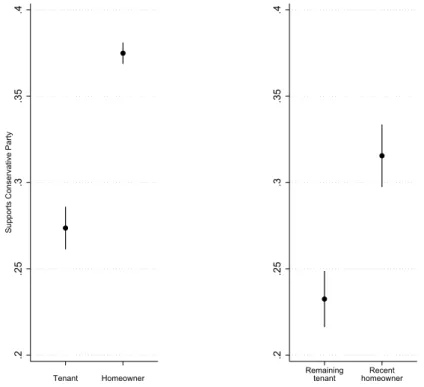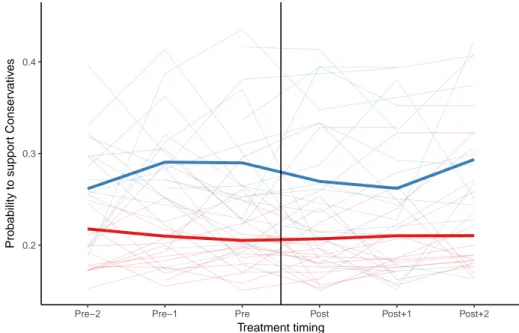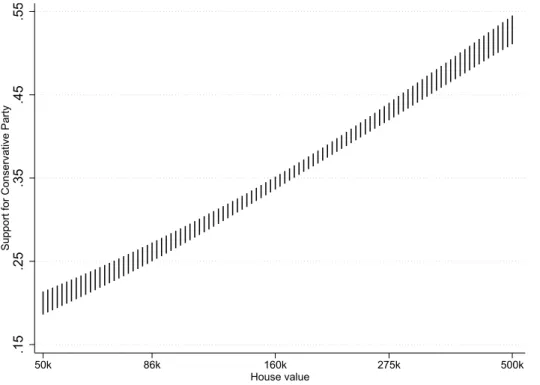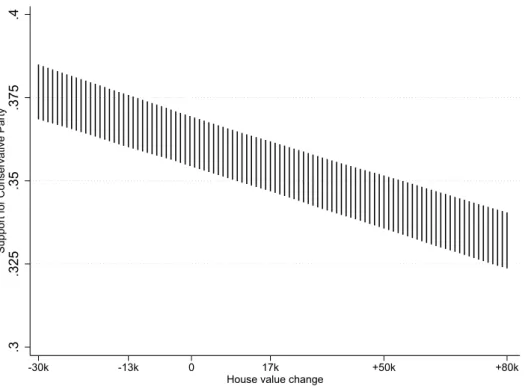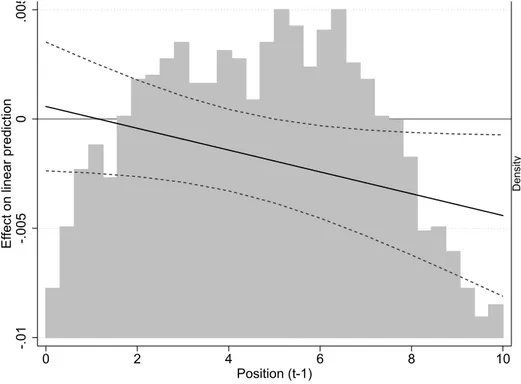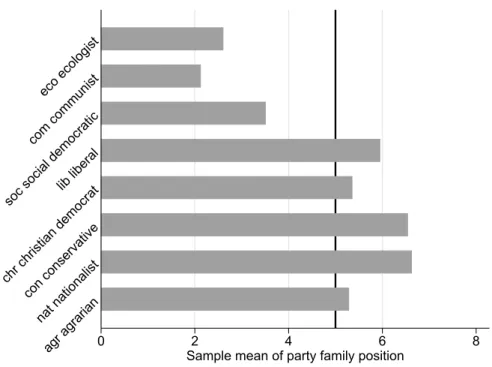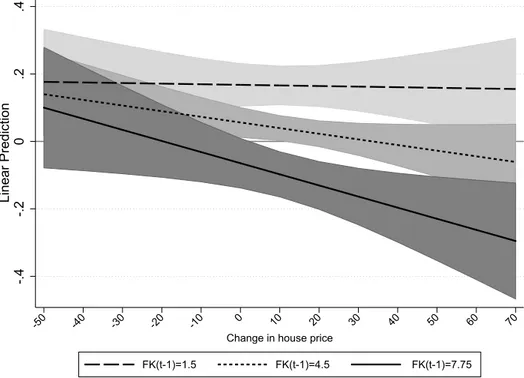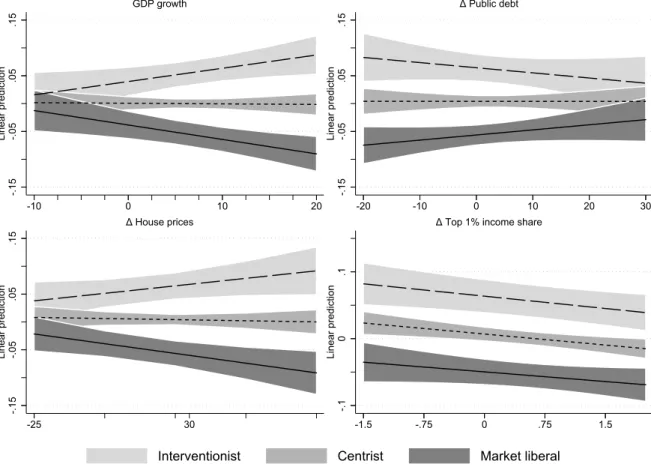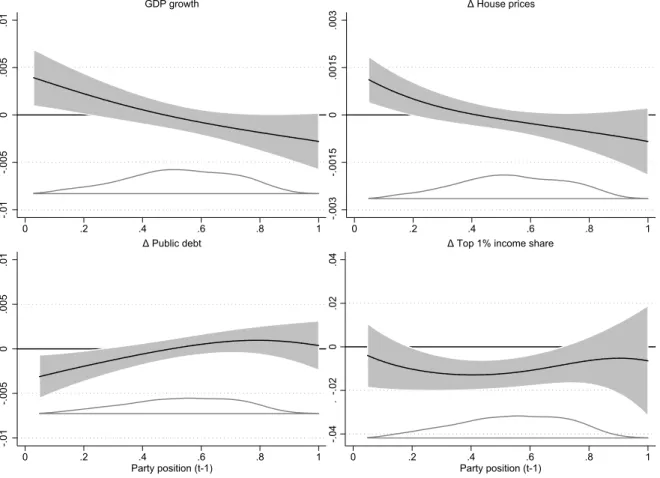A STRUCTURAL PERSPECTIVE ON VOTER-PARTY LINKAGES
The Political Implications of Housing and the Economy
Inauguraldissertation zur
Erlangung des Doktorgrades der
Wirtschafts- und Sozialwissenschaftlichen Fakult¨ at der
Universit¨ at zu K¨ oln
2018
vorgelegt von
Paul Beckmann, M.Sc.
aus
Reutlingen
Referent: Prof. Dr. Andr´ e Kaiser
Korreferent: Prof. Dr. Sven-Oliver Proksch
Tag der Promotion: 4. Februar 2019
ACKNOWLEDGEMENT
This dissertation is the result of four years of work at the Cologne Center for Compar- ative Politics. Four years ago, I could not imagine how demanding yet also rewarding this time would become. One thing, however, stands out: No matter how challenging the process appeared to me at times, I was extremely lucky to receive the support of many people along the way without whom this thesis would have been unthinkable.
I have to thank the Cologne Center for Comparative Politics to be such an inspiring place to do research. In particular, I would like to thank my supervisor Andr´ e Kaiser for his support and guidance throughout the last four years. I owe him a great debt of gratitude for allowing me to become part of the CCCP in the first place. I am grateful for his support and his encouragement along the way. I appreciate his comments on early stages of my work in the research seminar and in private which helped me a great deal to make progress. I would also like to thank my second supervisor, Sven-Oliver Proksch, for his support and trust. It was a very exciting and fascinating opportunity to work with him and to support him while settling in at the University of Cologne. I could not have thought of a better motivation boost in terms of teaching and research which came at a good point in time. Besides, I would like to thank the Cologne Graduate School for the scholarship and Dagmar Weiler, in particular, for financial and administrative support without which the doctorate would not have been possible.
Beyond that, I would like to thank my colleagues at the Cologne Center for Com-
parative Politics. Without their brilliant advice in research seminars and stimulating
discussions in the hallway or over lunch, I would not have succeeded to finish my dis-
sertation. I am particularly indebted to Sarah Berens, Jan Sauermann, Holger Rein-
ermann and Leonce R¨ oth. Sarah’s never-ending willingness to comment on various
pieces of my work and to help me with typical struggles of everyday life in academia
has been both an example and an unbelievable support. I am similarly grateful to
Jan who was kind enough to include me in his project and with whom I have spent
many, many days in the laboratory. Working with him on our joint projects has been
a source of inspiration and taught me many useful things which helped during the
doctorate. I want to thank Holger Reinermann for his continued support, in particular
during the two and a half years we shared an office together. I have always enjoyed the
opportunity to discuss the ”research problem of the day” with him. I would also like
to thank Leonce Ro¨th for his assistance and his co-authorship to chapter four of this
dissertation. Working on the article together has been a lot of fun and I will miss the
opportunity to solve methodological puzzles over lunch. I am additionally very grateful to Dennis Abel, Armin Mertens, Kristina Gushchina, Jens W¨ ackerle, Michael Schwan and all other colleagues who made the time at the CCCP such a valuable experience and for being good office mates, colleagues or companions for a (good) cup of coffee at all times.
Besides my colleagues at work, I am particularly gifted to have received support of a large number of friends and family members. A doctoral thesis can seem to be a pretty steep hill to climb at times and I would definitely have turned around without their support. There is first of all, of course, Marina, who I am incredibly lucky and privileged to have by my side. Knowing that she had my back whatever comes made this doctoral thesis possible in the first place. Her unwavering, loving support, patience and cheerful mood made the past four years an amazing time. I am also indebted to both my and Marina’s family. I thank my parents, Jane and Wolfgang, for their endless encouragement and their faith in me. Without their support and generosity, I would never have enjoyed so many opportunities. I am also thankful to my siblings Anne, Ruth, Lisa and Frieder and their families for being, well, such a great family. A special thanks for making Cologne my second home and for allowing me to have a second family goes to Adrienne, Ansgar, Sara, Alex, Johanna, Jan and their (numerous) kids.
Having you around at so many occasions is a privilege. Ultimately, I want to thank
all my friends from various places who have done and continue to do a very good job
of keeping me busy outside of work. I guess it was a very healthy thing to have all of
you around to keep my mind off this thesis from time to time.
CONTENTS
1 Introduction 1
1.1 The politics of housing and homeownership . . . . 3
1.2 Theories of party competition and party politics . . . . 7
1.3 Theoretical framework . . . . 10
1.4 Overview of included studies . . . . 12
1.4.1 Chapter 2 . . . . 12
1.4.2 Chapter 3 . . . . 14
1.4.3 Chapter 4 . . . . 15
1.5 Relevance and broader implications . . . . 16
1.6 Publication status of the articles . . . . 18
2 Patrimonial Economic Voting in the UK: Homeownership and House Price Appreciation 19 2.1 Introduction . . . . 19
2.2 Patrimonial economic voting . . . . 21
2.3 Patrimonial economic voting and homeownership . . . . 22
2.4 Empirical approach . . . . 24
2.4.1 The case: Homeownership in the UK . . . . 24
2.4.2 The data and empirical strategy . . . . 25
2.4.3 Estimation and sample . . . . 26
2.5 Results . . . . 28
2.5.1 Homeownership and transition into homeownership . . . . 28
2.5.2 House price volatility . . . . 33
2.6 Conclusion . . . . 36
3 An Asymmetric Partisanship Effect: House Price Fluctuations and Party Positions 39 3.1 Introduction . . . . 39
3.2 How parties take positions and target voters . . . . 41
3.3 The argument . . . . 42
3.4 The case: Housing markets . . . . 44
3.5 Parties’ responses to house price fluctuations . . . . 46
3.6 Measurement, model specification and data . . . . 47
3.6.1 Measuring party positions . . . . 47
3.6.2 Variables of interest and controls . . . . 48
3.6.3 Data structure and model specification . . . . 49
3.7 Results . . . . 50
3.8 Discussion . . . . 54
4 Asymmetric Responsiveness: The Effects of Socio-economic Devel- opments on Party Position Shifts 57 4.1 Introduction . . . . 58
4.2 How socio-economic developments affect party position taking . . . 59
4.3 The empirical verification. Identification, data, and results . . . . . 62
4.3.1 Selection of socio-economic developments . . . . 62
4.4 Case selection, data, and identification at the party level . . . . 65
4.4.1 Case selection . . . . 65
4.4.2 Data . . . . 65
4.4.3 Identification . . . . 66
4.4.4 A general identification procedure for necessary control variables . . 67
4.5 Results . . . . 68
4.6 Conclusion . . . . 74
5 Supplementary Material 77 SM1 Patrimonial Economic Voting in the UK: Homeownership and House Price Appreciation . . . . 78
SM1.1 Transition to homeownership . . . . 78
SM1.1.1 Summary statistics . . . . 78
SM1.1.2 Incumbency effects . . . . 79
SM1.1.3 Alternative dependent variables . . . . 81
SM1.2 House price developments . . . . 85
SM1.2.1 Summary statistics . . . . 85
SM1.2.2 Incumbency effects . . . . 86
SM1.2.3 Official house price index . . . . 88
SM2 An Asymmetric Partisanship Effect: House Price Fluctuations and Party Positions . . . . 89
SM2.1 Measuring party positions: Description and additional results . . . 90
SM2.2 Empirical results - full tables and robustness checks . . . . 95
SM3 Asymmetric Responsiveness. The Effects of Socio-economic Devel- opments on Party Position Shifts . . . 110
SM3.1 Covariate selection . . . 110
SM3.2 Verification of clustered standard errors . . . 116
SM3.3 Additional results: Tables and graphs . . . 117
SM3.3.1 Robustness: Alternative specifications and control variables config- urations . . . 119
Bibliography 131
LIST OF FIGURES
1.1 Evolution of homeownership in OECD countries. . . . . 4 1.2 Evolution of house prices in OECD countries. . . . 5 2.1 Homeownership and transition to homeownership and probability to
vote Conservative . . . . 30 2.2 Mean pre- and post-treatment probabilities to support the Tories by
ownership . . . . 32 2.3 Effect of house value levels on probability to support Conservatives 35 2.4 Effect of changes in house values on probability to vote Conservative 36 3.1 Marginal effects of house price change over previous party position 52 3.2 Average party position by party family (across all elections); based
on CMP party family coding . . . . 53 3.3 Predicted responsiveness to different house price changes, by previ-
ous party position (from left to right: left-wing, centrist, right-wing) 54 4.1 Linear predictions of socio-economic developments on party position
shifts . . . . 69 4.2 Marginal effect of socioeconomic treatments across the entire market
liberalism scale . . . . 70 4.3 Marginal effect of socioeconomic treatments across the entire market
liberalism scale by party type . . . . 72 SM1.1 Homeownership and transition to homeownership and probability to
vote Conservative by government incumbency . . . . 79 SM1.2 House price changes and probability to vote Conservative by incum-
bent government . . . . 86 SM2.1 Marginal effects of house price change over previous party position,
by measurement . . . . 92 SM2.2 Average party position by party family (across all elections); based
on CMP party family coding, by measurement . . . . 93 SM2.3 Simulated responsiveness to different house price changes . . . . 94 SM2.4 Non-linear marginal effects of house prices on change in party posi-
tion, by measurement. . . . 99
SM3.1 Non-linear marginal effects with party fixed effects: full sample . . 122
SM3.2 Non-linear marginal effects with party fixed effects: split sample . 122
SM3.3 Linear predictions: split sample . . . 123
SM3.4 Linear predictions with party fixed effects: full sample . . . 123
SM3.5 Linear predictions with party fixed effects: split sample . . . 124
SM3.6 Linear marginal effects: full sample . . . 124
SM3.7 Linear marginal effects: split sample . . . 125
SM3.8 Linear marginal effects with party fixed effects: full sample . . . . 125
SM3.9 Linear marginal effects with party fixed effects: split sample . . . . 126
SM3.10 Non-linear marginal effects for unemployment . . . 126
SM3.11 Linear predictions for unemployment variable . . . 127
SM3.12 Linear predictions: CMP RILE score . . . 127
SM3.13 Non-linear marginal effects: CMP RILE score . . . 128
LIST OF TABLES
2.1 Homeownership: Logit Regressions . . . . 28
2.2 Transition to homeownership: Logit Regressions . . . . 29
2.3 Transition to homeownership: Difference-in-difference models . . . . 31
2.4 Self-reported house values: Logit Regressions . . . . 34
3.1 Determinants of shifts in party positions . . . . 51
4.1 Expected party system response to the selected indicators . . . . . 64
SM1.1 Summary statistics . . . . 78
SM1.2 Transition to homeownership: Labour and Tory governments . . . . 80
SM1.3 Homeownership: Tory identification as DV . . . . 81
SM1.4 Homeownership: Tory vote intention as DV . . . . 82
SM1.5 Transition to homeownership: Tory identification as DV . . . . 83
SM1.6 Transition to homeownership: Tory vote intention as DV . . . . 84
SM1.7 Summary statistics: self-reported house values and median house price index by constituency . . . . 85
SM1.8 House price changes: Labour and Tory governments . . . . 87
SM1.9 Constituency median house values: Logit Regressions . . . . 88
SM2.1 Summary statistics . . . . 89
SM2.2 Determinants of shifts in party positions – Full models: Franz- mann/Kaiser . . . . 95
SM2.3 Determinants of shifts in party positions – Full models: RILE . . . 96
SM2.4 Determinants of shifts in party positions – Full models: Benoit/Laver 97 SM2.5 Robustness – Models with lagged dependent variable . . . . 98
SM2.6 Robustness – Models with party fixed effects . . . 100
SM2.7 Robustness – Models with party random effects . . . 101
SM2.8 Robustness – Models with generalized least squares . . . 102
SM2.9 Robustness – Models with panel corrected standard errors . . . 103
SM2.10 Robustness – Models with Level Party Position as DV . . . 104
SM2.11 Robustness – Models with party-family based left-right dummies . . 105
SM2.12 Robustness – Models with interaction by party family . . . 106
SM2.13 Robustness – Models with interaction by party family dummies . . 107
SM2.14 Robustness – House price increase/decreases . . . 108
SM2.15 Robustness – Models with categorised house price changes . . . 109
SM3.1 Covariate selection . . . 111 SM3.2 Intracluster correlation of party position shifts within countries . . 116 SM3.3 Prais-Winsten regression results (models behind Figures 4.1, 4.2 and
4.3) . . . 117 SM3.4 Panel regression models with party fixed effects . . . 118 SM3.5 Robustness of main effect for each indicator . . . 119 SM3.6 Models with CMP RILE score as a left-right measurement of party
positions . . . 129
CHAPTER
ONE
INTRODUCTION
How voters and parties are linked and interact is one of the fundamental questions of democracy. After all, voters delegate power to political actors who take decisions on their behalf. At the core of a functioning relationship of representation, therefore, is some congruence in preferences between voters and parties. Many factors affect this relationship, ranging e.g. from electoral institutions to organisational structures.
An influence that is frequently discussed is the economy in general. It affects voters as it does affect political parties. Changes in the economy affect citizens’ economic prospects, standard of living, willingness to contribute to public goods and many more aspects. Parties are affected in their access to resources, discretion for policy-making when in government and, of course, on a policy level where voters expect parties to present policies to promote their and others’ well-being. It follows that the economy has very strong implications for political processes of representation and preference aggregation.
In this dissertation, I study to what extent structural characteristics on the indi- vidual level affect political behaviour and how these characteristics, on the aggregate level, create incentives for political parties in their programmatic positioning. A com- mon theme throughout this work is an interest in the political implications of economic processes. More precisely, I am mostly interested in the role of homeownership and variation in house prices on political processes on the individual and the party level.
As such, the structure of this thesis follows a stylised political process where structural
factors affect political behaviour on the micro level which then, on the aggregate, has
implications for political parties. Put differently, the chapters of this dissertation are
bound together by a politico-economic model that emphasises the relevance of the econ-
omy, and of housing and volatile housing markets in particular, on vote choice and party
competition. At the respective levels of analysis, I combine this more structural per-
spective on housing as an individual trait with political repercussions with well-known
approaches on political behaviour, party competition and political representation to
derive expectations. In combination, this dissertation focuses on voter-party linkages
and how these are affected by economic processes more generally.
At the heart of this dissertation is the insight that economic processes have costs and benefits which are unequally distributed across the electorate. The fact that some individuals are affected while others are not, forms a basic precondition for the political relevance of these processes. The ensuing idea is rather simple and not entirely new:
On the individual level, an economic process has different implications for political preferences and political behaviour of exposed individuals. Given these differences, political parties have incentives to respond to these developments if core voter groups are affected.
One very interesting economic phenomenon of this kind that has received little at- tention so far in comparative politics is housing. The most relevant difference on the micro level is whether individuals rent or own the home they live in. Homeowners and tenants differ on a variety of characteristics such as age, education or income.
Therefore, ownership status is linked to other criteria that are known to affect polit- ical behaviour and thus, as an individual characteristic, should have indirect effects.
However, thinking in more detail about the implications of homeownership, there are several additional channels through which it can take effects on politics. Most impor- tantly, changes in house prices strongly affect the economic and financial well-being of homeowners. While they benefit disproportionately from house price inflation, housing market corrections with decreasing prices have far-reaching negative consequences on household portfolios. Overall, homeownership as a trait of character and house price developments should have effects on individuals which drive political processes on the individual and the party level.
The papers that constitute this dissertation follow the idea of a micro-founded the- ory of individual and party behaviour. As stated before, the characteristic I am mostly looking at is asset ownership and the development of asset prices, in particular of hous- ing assets, and how they affect political behaviour. Therefore, the dissertation and my findings have implications for broader debates about the political consequences of homeownership and housing markets which have attracted growing scholarly attention in recent years. On the party level, I am then mostly interested to what extent the political implications of housing affect political parties. To do so, I develop a theo- retical argument about party responsiveness to core voter groups. In the third paper, I further develop this argument and generalise it beyond housing markets to other economic processes. The latter two papers, therefore, speak to debates about party competition, partisanship theory as well as political representation and political econ- omy in a broader sense. This introductory chapter has five purposes. Firstly, as all papers, to some extent, refer to homeownership and housing as a so far understudied economic phenomenon in political science, the next section will review the existing literature on the political economy of housing. Subsequently, I move to the litera- ture on party competition and partisan theory and review the most relevant literature.
Thirdly, I discuss the theoretical contributions of this dissertation in more detail and
clarify the implications of the work. Fourthly, I summarise the articles which consti-
tute this doctoral thesis before I ultimately discuss the implications of the dissertation’s
results.
1.1 The politics of housing and homeownership
Housing has become a salient issue over the past decade. Much attention has been given to housing finance and its role during the global financial crisis. Besides, housing- related problems remain major issues in many countries. In most places, affordable housing becomes increasingly scarce calling for action from policymakers. Given the specificity of the domestic housing system, the major issue concerns e.g. either high rental costs (e.g. in Germany) or high purchasing costs (e.g. in the UK) which lim- its access to homeownership with far-reaching consequences for individuals’ financial planning over the long run. From these debates, it is apparent that housing remains an important and heavily discussed issue across the globe. In this dissertation, I focus particularly on the ownership dimension of housing and how homeownership affects politics on the micro level.
To start off the discussion about the political implications of housing, it is worth- while to give an initial overview of the two main indicators of interest, homeownership rates and house prices fluctuations. Figure 1.1 shows the evolution of homeownership rates across OECD countries for the period from 1975 to 2010. The thick line on the left-hand side represents the per-year-average across countries. Several things are worth discussing on this graph. It is easy to see that homeownership levels vary quite largely between countries. Some countries remain below 50 per cent of homeowners through- out the entire period (Germany and Switzerland, see right panel) while others (e.g.
Great Britain) are substantively higher at values of up to 80 per cent (Norway). This points to different systems of housing provision across countries (Barlow and Duncan, 1994; Hoekstra, 2005). Looking at the evolution of homeownership, there is a posi- tive trend across countries implying that homeownership has grown, sometimes quite dramatically. In countries such as the Netherlands, typically characterised through a large public housing stock until the 1990s, homeownership massively expanded after the 1990s. In Norway, homeownership grew by 20 percentage points between 1975 and 1990. The average evolution shows a positive trend which washes out around the early 2000s and then remains at an average value of roughly 60 per cent homeowners. There is substantial cross-country and over-time variation in homeownership which highlight at interesting dynamics on housing markets.
Moving to the dynamics of house prices, Figure 1.2 plots house price indexes for a sample of about 20 OECD countries. The left-hand side displays level values while the right-hand side shows annual differences. Starting with the levels, there is substantial variation across countries and over time in house price developments. Across coun- tries, house prices on average grew steadily over the past 40 years. Only during the global financial crisis of 2007/2008, housing markets collapsed across sufficiently many countries to push down the overall average, as well. It is also evident that house prices grew to a varying extent across countries. In some countries, the index rose to more than four times the level of 1995 (e.g. Ireland or Norway) while in others they never surpassed twice the 1995-level. The panel on the right-hand side is equally interesting.
Two things stand out from the visualisation. Firstly, there are a substantial number
of cases where house prices decreased to the level of the previous year. Although more
variation is located above the zero intercept as the average line shows, there is a non-
30 40 50 60 70 80
1980 1990 2000 2010
Year
Homeo wnership r ate
Source: Own data collection
Norway
Germany Netherlands
Switzerland Great Britain
